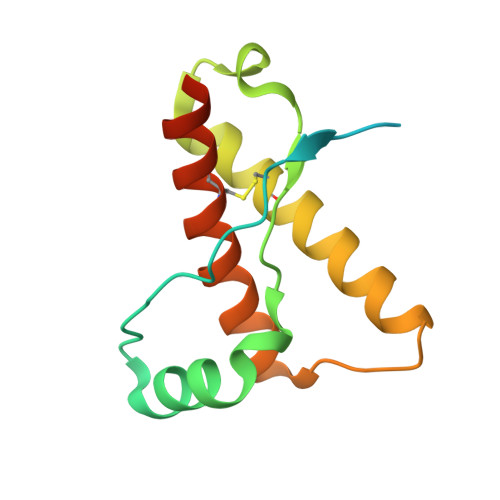N-Terminal Helix-Cap in alpha-Helix 2 Modulates beta-State Misfolding in Rabbit and Hamster Prion Proteins.
Sweeting, B., Brown, E., Khan, M.Q., Chakrabartty, A., Pai, E.F.(2013) PLoS One 8: e63047-e63047
- PubMed: 23675452
- DOI: https://doi.org/10.1371/journal.pone.0063047
- Primary Citation of Related Structures:
4HLS, 4HMM, 4HMR - PubMed Abstract:
Susceptibility of a particular species to prion disease is affected by small differences in the sequence of PrP and correlates with the propensity of its PrP to assume the β-state. A helix-cap motif in the β2-α2-loop of native α-helical rabbit PrP, a resistant species, contains sequence differences that influence intra- and interspecies transmission. To determine the effect the helix-cap motif on β-state refolding propensity, we mutated S170N, S174N, and S170N/S174N of the rabbit PrP helix-cap to resemble that of hamster PrP and conversely, N170S, N174S, and N170S/N174S of hamster PrP to resemble the helix-cap of rabbit PrP. High-resolution crystal structures (1.45-1.6 Å) revealed that these mutations ablate hydrogen-bonding interactions within the helix-cap motif in rabbit PrP(C). They also alter the β-state-misfolding propensity of PrP; the serine mutations in hamster PrP decrease the propensity up to 35%, whereas the asparagine mutations in rabbit PrP increase it up to 42%. Rapid dilution of rabbit and hamster into β-state buffer conditions causes quick conversion to β-state monomers. Kinetic monitoring using size-exclusion chromatography showed that the monomer population decreases exponentially mirrored by an increase in an octameric species. The monomer-octamer transition rates are faster for hamster than for rabbit PrP. The N170S/N174S mutant of hamster PrP has a smaller octamer component at the endpoint compared to the wild-type, whereas the kinetics of octamer formation in mutant and wild-type rabbit PrP are comparable. These findings demonstrate that the sequence of the β2-α2 helix-cap affects refolding to the β-state and subsequently, may influence susceptibility to prion disease.
- Department of Medical Biophysics, University of Toronto, Toronto, Ontario, Canada.
Organizational Affiliation:



















